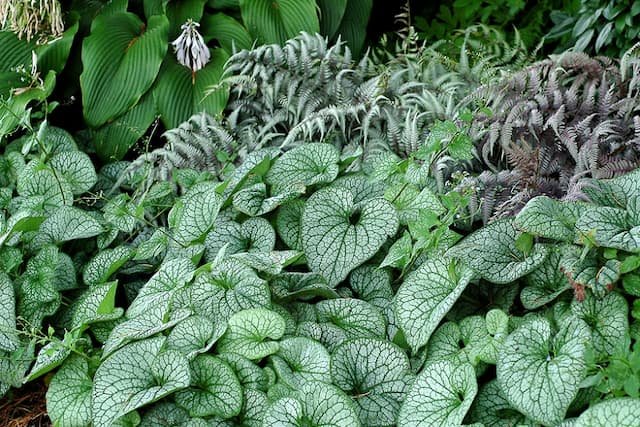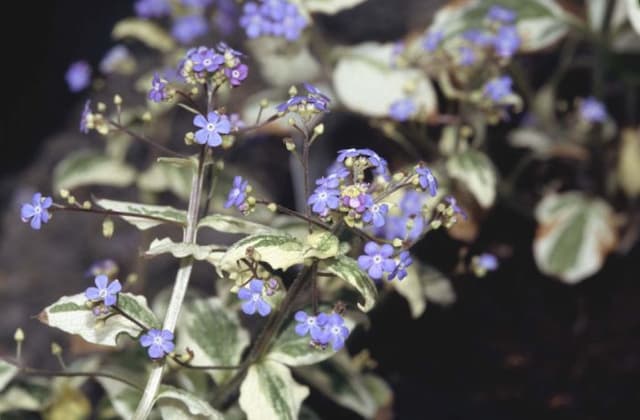Lungwort Pulmonaria saccharata 'Mrs Moon'
ABOUT
Pulmonaria saccharata 'Mrs Moon', commonly known as Lungwort, is a herbaceous perennial that is appreciated for its decorative foliage and springtime flowers. The leaves of Lungwort are one of its most distinctive features, characterized by their oval shape with a softly hairy texture. They have a unique mottled pattern of silver and green, providing an eye-catching display even when the plant is not in bloom. The flowers of 'Mrs Moon' emerge in clusters on stems that rise above the foliage. These blossoms are notable for their color-changing ability. They start off as pink buds and then transition to a striking shade of blue as they mature. This dual-toned flowering can lead to a charming multicolored effect on a single plant. The funnel-shaped flowers are dainty and attract pollinators such as bees. Overall, the Lungwort 'Mrs Moon' presents a charming blend of ornately patterned foliage and enchanting, color-changing flowers, making it a popular choice for shaded gardens where it can light up the understory with its variegated leaves and lovely blooms. Its appeal is in the texture and color it adds to the landscape rather than its physical stature.
About this plant
 Names
NamesFamily
Boraginaceae.
Synonyms
Lungwort, Bethlehem Sage, Jerusalem Cowslip, Mary's Tears, Soldiers And Sailors.
Common names
Pulmonaria saccharata 'Mrs. Moon'.
 Toxicity
ToxicityTo humans
Lungwort (Pulmonaria saccharata 'Mrs Moon') is generally not considered toxic to humans. There is no widespread documentation of poisoning from the ingestion of this plant, which suggests the absence of significant toxic compounds. Therefore, it typically does not pose a risk if accidentally ingested in small quantities. However, as with any non-food plant, there is always a risk of individual allergic reactions or gastrointestinal discomfort such as nausea or diarrhea.
To pets
Lungwort (Pulmonaria saccharata 'Mrs Moon') is also not considered toxic to pets such as dogs and cats. It is not listed as a plant with known toxicity to pets by major animal health organizations, which implies that pets that ingest the leaves or flowers of Lungwort are unlikely to suffer from serious poisoning symptoms. However, mild gastrointestinal upset cannot be ruled out if a pet consumes large amounts of the plant. It is always advisable to discourage pets from eating non-food plants to avoid any potential issues.
 Characteristics
CharacteristicsLife cycle
Perennials
Foliage type
Semi-deciduous
Color of leaves
Variegated
Flower color
Mixed
Height
1 foot (30 cm)
Spread
1 foot (30 cm)
Plant type
Herb
Hardiness zones
3
Native area
Europe
Benefits
 General Benefits
General Benefits- Attractive foliage: The distinctive green leaves of Lungwort are often mottled or spotted with silver, adding visual interest even when the plant is not in bloom.
- Early spring blooms: Lungwort produces colorful flowers early in the spring, providing a welcome splash of color after the winter months.
- Shade tolerance: This plant thrives in shaded areas, making it a great choice for adding life to darker parts of a garden.
- Drought resistance: Once established, Lungwort can be quite tolerant of dry conditions, requiring less frequent watering.
- Pollinator friendly: The flowers attract bees and other pollinators, which are vital for the health of gardens and ecosystems.
- Ground cover: Lungwort can help to cover bare spots in the garden, and its dense growth habit can help suppress weed growth.
- Easy to grow: This hardy perennial is fairly low maintenance and can grow well in a variety of soil types.
- Seasonal interest: The plant provides visual interest for much of the year, from the early spring flowers to the attractive foliage that often lasts into the fall.
 Medical Properties
Medical PropertiesThis plant is not used for medical purposes.
 Air-purifying Qualities
Air-purifying QualitiesThis plant is not specifically known for air purifying qualities.
 Other Uses
Other Uses- Lungwort can be used in dye production, specifically the leaves, which may yield a range of colors from yellow to green when used as a natural dye for fabrics or yarn.
- The plant is sometimes incorporated into wildlife gardens as it provides early nectar for bees and other pollinating insects emerging in the spring.
- Lungwort leaves may be used in compost piles as a source of green material, contributing to the nitrogen content necessary for effective composting.
- The plant's unique patterned leaves can serve as an inspiration for artists and designers, offering interesting textures and shapes for eco-printing on paper or fabric.
- Gardeners might use lungwort as a living educational tool to demonstrate symbiotic relationships, as it often harbors a benign fungus that creates its signature leaf markings.
- Lungwort can be utilized as a ground cover in shaded areas to suppress weeds with its dense foliage.
- In permaculture, lungwort can be planted under deciduous trees as part of a forest garden layer, providing ground cover and spring flowers.
- Its durability in the shaded environment makes lungwort a useful plant for restoration projects in woodland settings, helping to stabilize soil.
- Lungwort can be a source of inspiration for landscape architects and gardeners when designing shade gardens or woodland-themed landscapes.
- Children can learn botany basics by observing lungwort's changing flowers, which transition in color from pink to blue, indicating its acidity or alkalinity to young learners.
Interesting Facts
 Feng Shui
Feng ShuiThe Lungwort is not used in Feng Shui practice.
 Zodiac Sign Compitability
Zodiac Sign CompitabilityThe Lungwort is not used in astrology practice.
 Plant Symbolism
Plant Symbolism- Healing: Pulmonaria, commonly known as Lungwort, has a history of being used to treat lung diseases, symbolizing restoration and healing.
- Perseverance: Lungwort blooms early in spring, often pushing through snow, which represents the ability to overcome challenges.
- Compassion: The soft, spotted leaves of the Lungwort can symbolize tenderness and care, as the plant has been used medicinally to soothe ailments.
- Protection: Since Lungwort has been valued for its medicinal properties, it has come to represent safety and protection against illness.
 Water
WaterLungwort 'Mrs Moon' prefers consistently moist soil, so it is crucial to water the plant whenever the top inch of soil feels dry to the touch. As a general guideline, aim to water once per week, but be ready to adjust this schedule according to temperature and humidity conditions. Typically, use about 1 gallon of water per plant for each watering session to ensure the soil is thoroughly moistened, but not soggy. During hot or windy weather, lungwort may require more frequent watering. Always avoid overhead watering to prevent leaf diseases, and try to water early in the morning to allow any excess water on the leaves to evaporate during the day.
 Light
LightLungwort 'Mrs Moon' thrives best in partial to full shade, as too much direct sunlight can scorch its leaves. A location that receives dappled sunlight throughout the day or shade during the afternoon is ideal. It is well-suited for spots under trees or on the north side of buildings where it can be protected from the harsh rays of the midday sun.
 Temperature
TemperatureLungwort 'Mrs Moon' is hardy and can survive in a range of temperatures, but it prefers a cooler climate. It can withstand minimum temperatures down to about -30°F and will remain hardy up to 80°F, although it does best in temperatures between 55°F and 75°F. Avoid placing it in areas where it could be exposed to extreme heat, as this can stress the plant.
 Pruning
PruningLungwort 'Mrs Moon' should be pruned to remove any faded or damaged leaves and to maintain its shape. Pruning is typically done after flowering in late spring or early summer. This not only tidies the plant but also encourages new growth. Cut back the foliage by about a third to stimulate fresh leaves. Pruning can also be performed as needed throughout the growing season to remove any leaves affected by mildew or other disease.
 Cleaning
CleaningAs needed
 Soil
SoilLungwort 'Mrs Moon' thrives best in a soil mix that is well-draining and rich in organic matter, with a pH range of 6.0 to 7.0. A combination of garden soil, peat moss or well-rotted compost, and a handful of perlite or coarse sand can create an ideal environment for this woodland perennial.
 Repotting
RepottingLungwort 'Mrs Moon' typically doesn't need frequent repotting as it's often grown as a garden perennial, but if grown in containers, repotting every 2-3 years or when root-bound is sufficient.
 Humidity & Misting
Humidity & MistingLungwort 'Mrs Moon' prefers a humid environment, which mimics its natural woodland habitat, but it is also quite adaptable to average home humidity levels.
 Suitable locations
Suitable locationsIndoor
Place in filtered light and keep soil moist.
Outdoor
Plant in partial shade and moist soil.
Hardiness zone
4-8 USDA
 Life cycle
Life cycleLungwort 'Mrs Moon' begins its life cycle with seed germination in moist, well-drained soil, typically in spring or autumn. After germination, seedlings emerge, developing a basal rosette of leaves. As the plant matures, elongated, hairy leaves with silver spots or blotches form, and lungwort 'Mrs Moon' enters its vegetative stage, focusing on growth and energy accumulation. In early to mid-spring, flowering stems rise above the foliage, bearing clusters of flowers that often change color as they mature, from pink to blue-purple. Following the blooming period, the plant sets seed, which can self-sow in suitable growing conditions. In preparation for winter, lungwort 'Mrs Moon' becomes dormant, with its leaves dying back, to re-emerge and repeat the cycle the following spring.
 Propogation
PropogationPropogation time
Spring-Early Summer
Pulmonaria saccharata 'Mrs Moon', also known as Lungwort, is best propagated during the spring or early summer. The most popular method of propagation for this plant is by division. This involves carefully digging up the established plant and gently separating it into smaller sections, making sure that each new piece has a portion of the root system. You can use a sharp knife or spade to help split the plant if it is particularly large or tough. Once divided, the new plants should be immediately transplanted into their new locations, maintaining the same soil depth as before. It is important to water the new divisions well after planting to help establish them.









